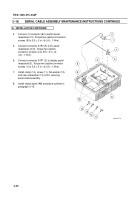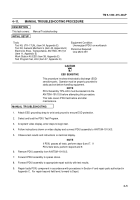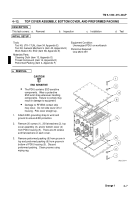TM-9-1200-215-34-P - Page 118 of 266
TM 9–1200–215–34&P
4–4
b.
The PDIU consists of:
D
768k Memory CCA
D
Processor CCA
D
Signal Protection and Multiplexer CCA
D
Input/Output CCA
D
DC–DC Converter (Power Supply)
D
EMI Filter CCA
(1)
768k Memory CCA.
Serves as an extension of the processor CCA memory; stores system software and
various constants; data is accessed by the processor CCA over the PDIU station bus.
(2)
Processor CCA.
Provides a station bus interface for communicating with other PDIU circuit card
assemblies.
It also contains an interface which allows testing of the PDIU with external test equipment.
(3)
Signal Protection and Multiplexer CCA.
Protects the PDIU electronics from damage due to faults and
transients on incoming signal lines.
It provides overvoltage protection, short circuit protection, and inadvertent
grounding protection.
It also provides first and second level of signal input multiplexers.
(4)
Input/Output CCA.
Receives conditioned analog and digital signals from the signal
protection/multiplexer CCA and makes them available for reading by the microprocessor.
The entering signal
proceeds through the final multiplexers into a differential amplifier.
The output of the amplifier passes through a
programmable filter into a programmable gain amplifier and finally through a 12 bit analog–to–digital converter
(ADCON).
The output of the ADC is available to the station bus for reading by the processor CCA.
(5)
DC–DC Converter (Power Supply).
Receives conditioned 24 Vdc power from the Automatic Fire Control
System (AFCS) Power Conditioner Unit (PCU).
It supplies three regulated direct current voltage outputs:
+5
Vdc, –15 Vdc, and +15 Vdc.
The maximum power output of the power supply is 40 watts.
(6)
EMI Filter CCA.
Protects the PDIU circuitry from damage or inaccurate readings from EMI and prevents
EMI emission by the PDIU.
Isolates the CCAs from EMI noise caused by the power supply.
4–10.
INITIAL FAULT INDICATION
a.
A status light on the PDIU electrical indicator panel indicated a PDIU failure.
(1)
The green indicator light (POWER) did not come on when power was applied to the PDIU.
(2)
The red indicator light (BIT) came on when input power was applied to the PDIU and did not go off after
20 seconds.
(3)
The red indicator light blinks continually at powerup and resumes blinking after the powerup procedure is
repeated.
(4)
The red indicator light comes on during operation.
BIT runs continually when the PDIU is in operation.
b.
When a PDIU failure has been detected, proceed to further troubleshoot the PDIU by using the Electronic
Shop, Transportable, AN/TSM–191(V)3.
Results from this fault isolation will indicate PDIU component(s)
requiring replacement.
The LRU troubleshooting procedure is presented in paragraph 4–11.
Back to Top




















